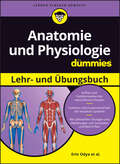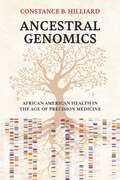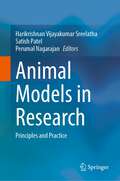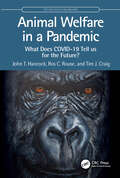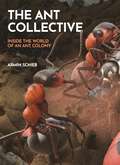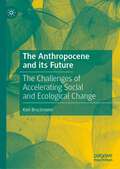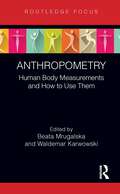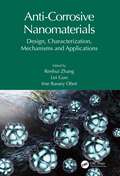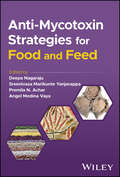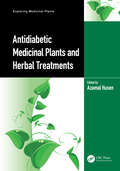- Table View
- List View
Analyzing Education, Sustainability, and Innovation: Multidisciplinary Research Perspectives (SpringerBriefs in Applied Sciences and Technology)
by Andreas Öchsner Azman Ismail Mohd Amran Mohd Daril Fatin Nur Zulkipli Rahimah MahatThis book describes a diverse array of studies unravelling the intricate interplay of education, sustainability, and organizational dynamics. From innovative teaching methodologies to sustainability trends and the pandemic's impact, this compendium offers a rich tapestry of insights. This book traverses through a compendium of studies that intricately dissect the synergy between education, sustainability, and organizational dynamics. This book is ideal for academics, practitioners, and curious minds seeking a deeper understanding of these vital contemporary forces.
Anatomie und Physiologie Lehr- und Übungsbuch für Dummies (Für Dummies)
by Erin Odya Donna Rae Siegfried Janet Rae-Dupree Pat DuPreeIhr Fahrplan für den menschlichen Körper Ergründen Sie den menschlichen Körper und seine Funktionsweise! Die Fächer Anatomie und Physiologie sind komplex, aber mit der richtigen Herangehensweise beherrschen Sie diese spannenden Themen im Nu. Der Schlüssel zum Erfolg heißt: erst verstehen und dann durch Üben nachhaltig einprägen. Dieses farbig illustrier-te Lehr- und Übungsbuch zeigt Ihnen, wie die unterschiedlichen Systeme des Körpers zusammenarbeiten. Sie erfahren alles über Organe, Knochen, Muskeln, Zellen, Hormone und vieles mehr. Mit Abbildungen zum Beschriften und Ausmalen sowie zahlreichen Übungsaufgaben ist die Prüfungsvorbereitung ganz einfach. Sie erfahren Wie Sie Knochen, Muskeln und Organe erkennen und lokalisieren Wie Kreislauf und Nerven-system funktionieren Was Sie über die Biochemie des Stoffwechsels wissen sollten Wie sich Krankheiten auf den Körper auswirken
Ancestral Genomics: African American Health in the Age of Precision Medicine
by Constance B. HilliardA leading evolutionary historian offers a radical solution to racial health disparities in the United States.Constance B. Hilliard was living in Japan when she began experiencing joint pain. Her doctor diagnosed osteoarthritis—a common ailment for someone her age. But her bloodwork showed something else: Hilliard, who had never had kidney problems, appeared to be suffering from renal failure. When she returned to Texas, however, a new round of tests showed that her kidneys were healthy. Unlike the Japanese doctor, her American primary care provider had checked a box on her lab report for “African American.” As a scholar of scientific racism, Hilliard was perplexed. Why should race, which experts agree has no biological basis, matter for getting accurate test results?Ancestral Genomics is the result of Hilliard’s decade-long quest to solve this puzzle. In a masterful synthesis of evolutionary history, population genetics, and public health research, she addresses the usefulness of race as a heuristic in genomic medicine. Built from European genetic data, the Human Genome Project and other databases have proven inadequate for identifying disease-causing gene variants in patients of African descent. Such databases, Hilliard argues, overlook crucial information about the environments to which their ancestors’ bodies adapted prior to the transatlantic slave trade. Hilliard shows how, by analyzing “ecological niche populations,” a classification model that combines family and ecological histories with genetic information, our increasingly advanced genomic technologies, including personalized medicine, can serve African Americans and other people of color, while avoiding racial essentialism.Forcefully argued and morally urgent, Ancestral Genomics is a clarion call for the US medical community to embrace our multigenomic society.
Animal Models in Research: Principles and Practice
by Harikrishnan Vijayakumar Sreelatha Satish Patel Perumal NagarajanThis book describes the development of animal models widely used in biomedical research using step-wise instructions and photographs. Showcasing a wide range of species from zebra fishes, birds, rodents, rabbits, dogs, and pigs, the book includes detailed methodology on how to work with these species and to develop various models. The animal models in neurology including stroke, Alzheimer’s disease, Parkinson’s disease, and Schizophrenia; Animal models in cancer research, sleep disorders, and cardiovascular diseases are described to meet the understanding of researchers who plan to replicate these models in their laboratories. In depth detailing on the development of targeted gene knockouts and transgenics, implantation models that are used in toxicology studies, and pharmacokinetic studies in pigs and dogs are a highlight. Further, the book describes pharmacologic, chemically induced, surgically induced, microbiologically induced, infectious models, models for neurobehavioral studies, oncology research, and pain research. The book has dedicated sections on anesthesia and analgesia and teaches procedures like venous cut-downs and cannulations in pigs and dogs, and endotracheal intubation, mechanical ventilation and thoracotomy in rodents and will serve as a self-training tool. Concepts in the field of animal model development are explained using examples. Sample size selection, study design, and statistical evaluation of experiments involving laboratory animals are explained to enable young researchers to practically understand the nuances. This book will be a valuable tool for academicians, students, scientists, and veterinarians and will benefit equally who are new to the field and who are already working with laboratory animals.
Animal Welfare in a Pandemic: What Does COVID-19 Tell us for the Future? (CRC One Health One Welfare)
by John T. Hancock Ros C. Rouse Tim J. CraigAnimal Welfare in a Pandemic explores the impact of COVID-19 on a wide array of animals, from those in the wild to companion and captive animals. During the height of the pandemic, a range of animals were infected, and many died, but this was hard to predict, even using up-to-date bioinformatics. Lockdowns around the world had, and continue to have, a major effect on animals’ welfare, influencing pet ownership and care, as well as impacting on the work of conservation institutes due to the lack of visitors and funding and lack of tourist presence in the wild which impacted on anti-poaching efforts. Some of the vast amount of personal protection equipment (PPE) that was distributed was discarded, creating both dangers and occasional opportunities for wild animals. With the rollout of human vaccines, some countries started developing animal vaccines, only some of which were deployed. In summary, the pandemic had a wide-ranging influence on animal welfare around the world. This is reviewed to highlight what can be learned to protect and enhance animal welfare in future epidemics/pandemics, and contribute to a genuinely One Health approach where the health and welfare of both humans and animals are considered holistically.This book is authored by members of the University of the West of England, Bristol, who span a range of expertise in Biological Sciences, Social Sciences, Animal Welfare, and Ethics.
Animal Welfare in a Pandemic: What Does COVID-19 Tell us for the Future? (CRC One Health One Welfare)
by John T. Hancock Ros C. Rouse Tim J. CraigAnimal Welfare in a Pandemic explores the impact of COVID-19 on a wide array of animals, from those in the wild to companion and captive animals. During the height of the pandemic, a range of animals were infected, and many died, but this was hard to predict, even using up-to-date bioinformatics. Lockdowns around the world had, and continue to have, a major effect on animals’ welfare, influencing pet ownership and care, as well as impacting on the work of conservation institutes due to the lack of visitors and funding and lack of tourist presence in the wild which impacted on anti-poaching efforts. Some of the vast amount of personal protection equipment (PPE) that was distributed was discarded, creating both dangers and occasional opportunities for wild animals. With the rollout of human vaccines, some countries started developing animal vaccines, only some of which were deployed. In summary, the pandemic had a wide-ranging influence on animal welfare around the world. This is reviewed to highlight what can be learned to protect and enhance animal welfare in future epidemics/pandemics, and contribute to a genuinely One Health approach where the health and welfare of both humans and animals are considered holistically.This book is authored by members of the University of the West of England, Bristol, who span a range of expertise in Biological Sciences, Social Sciences, Animal Welfare, and Ethics.
The Ant Collective: Inside the World of an Ant Colony
by Armin SchiebAnts come alive on this fabulously illustrated journey into the heart of a bustling colonyAnts share a vibrant and complex communal life and remarkable abilities to communicate with each other. The Ant Collective presents the world of ants as you have never seen it before, using hyperrealistic, computer-generated imagery that shows 3D-like views of activities inside and outside a thriving nest of red wood ants. With chapters on topics ranging from the establishment and construction of the nest to the birth of an ant trail and the relocation of a colony, this one-of-a-kind book brilliantly integrates informative descriptions with the illustrations, drawing on the latest science to reveal the innermost workings of the colony and enabling you to explore the ant collective as if you are there.Features a wealth of naturalistic 3D-like illustrations and schematic infographicsDepicts the anatomy of ants, the architecture of their nests, their interactions with the environment and other animals, and their collective social behaviorFollows the annual life cycle of the colonyProvides an incredible up-close look at ant reproduction, defense, foraging, nesting, division of labor, and morePacked with information about the biology, ecology, and communication skills of these marvelous insects
Antenna Systems for Modern Wireless Devices (Signals and Communication Technology)
by Shiban K. Koul S. Swapna G. S. KarthikeyaThis book presents up-to-date information about WLAN antenna designs for students, researchers, and professionals who want to design radiating systems to be deployed for practical coverage. The book primarily focuses on pattern diversity antennas. Pattern diversity antennas are very vital in wireless communication. High correlation between multiple signals can result in low data throughput which can be solved by using antennas with pattern diversity. Beam scanning antennas and their variants are also described in detail. Pattern diversity antenna systems with multiport feeds are also comprehensively discussed in this book. For a multiport system to maintain a reasonable link budget, equal antenna gains are preferred for the required antenna coverage. The book further describes the latest techniques to enhance and equalize the antenna gain within a compact radiating system. With increasing demand for faster connectivity with minimum path loss, the demand for high-gain antennas is rapidly increasing. Thereby a detailed discussion on gain enhancement with the latest high-gain antenna designs is requisite while describing WLAN antennas. Some antenna designs discussed in the book are based on additive manufacturing for their design and fabrication. Additive manufacturing is a much sought-after technology today that allows rapid development of antennas at an affordable cost. Many recent WLAN antennas make use of this technology to develop versatile antenna designs. Finally, the book includes a section on wide-band antenna designs. Antenna designs that reduce the scanning loss are also discussed.
The Anthropocene and its Future: The Challenges of Accelerating Social and Ecological Change
by Karl BruckmeierThis book analyses the complex social and ecological processes of the Great Acceleration, the Great Transformation, and sustainable development that shape the future of the global society in the twenty-first century. The first process takes place for a longer time, the second over the past thirty years, with attempts to build a sustainable economy and society in the global policy of sustainable development. The processes and their interaction will be discussed with knowledge from inter- and transdisciplinary transformation research, social and political ecology, and theories of modern society. The guiding theoretical concepts for the social-ecological transformation will be clarified: the concepts of acceleration, transformation, and sustainable development, and the societal and ecological processes they include. To obtain a more detailed picture of the changes in the global social-ecological system, different parts of the global transformation, the digital transformation, the transformation of food systems, and the transformation of modes of living in the social lifeworld are described to show the complex changes in the epoch of the Anthropocene more concretely. The global change processes in society and nature are caused by human forces but are difficult to control through policy and governance. With the interdisciplinary integration of concepts and knowledge, it becomes possible to provide a more detailed picture, of the difficulties to achieve a sustainable future society.
Anthropometry: Human Body Measurements and How to Use Them (Body of Knowledge in Human Factors and Ergonomics)
by Beata Mrugalska Waldemar KarwowskiToday, human factors and ergonomics professionals worldwide contribute to the design and evaluation of tasks, jobs, products, environments, and systems in order to make them compatible with the needs, abilities, and limitations of people. By understanding anthropometry, professionals can ensure that our home and working environments are comfortable and designed with the human in mind. This book aims to show how an understanding of anthropometrics can influence workspace design, ergonomics in the office, ergonomics in the home, and health and safety at work. This book discusses the measurement of the human body and human variability. Anthropometry may seem to be relatively simple but the reality is that it focuses on very sophisticated aspects of how to make the products tailor-made to suit specific requirements. As a study, it is useful for a variety of purposes such as workspace design, ergonomics in the office, ergonomics in the home, and health and safety at work. These eleven chapters investigate anthropometrics and bridge the gap between theory and practice. Each chapter is supported by tables, charts, and illustrations, and a wide list of bibliographic references. The reader will develop new insights into the principles and practice of anthropometrics with this book bringing the topic right up to date. Anthropometry: Human Body Measurements and How to Use Them will be of interest to students, graduates, teachers, researchers, and general workers in industrial design, ergonomics, rehabilitation, safety, and health.
Anthropometry: Human Body Measurements and How to Use Them (Body of Knowledge in Human Factors and Ergonomics)
by Beata Mrugalska Waldemar KarwowskiToday, human factors and ergonomics professionals worldwide contribute to the design and evaluation of tasks, jobs, products, environments, and systems in order to make them compatible with the needs, abilities, and limitations of people. By understanding anthropometry, professionals can ensure that our home and working environments are comfortable and designed with the human in mind. This book aims to show how an understanding of anthropometrics can influence workspace design, ergonomics in the office, ergonomics in the home, and health and safety at work. This book discusses the measurement of the human body and human variability. Anthropometry may seem to be relatively simple but the reality is that it focuses on very sophisticated aspects of how to make the products tailor-made to suit specific requirements. As a study, it is useful for a variety of purposes such as workspace design, ergonomics in the office, ergonomics in the home, and health and safety at work. These eleven chapters investigate anthropometrics and bridge the gap between theory and practice. Each chapter is supported by tables, charts, and illustrations, and a wide list of bibliographic references. The reader will develop new insights into the principles and practice of anthropometrics with this book bringing the topic right up to date. Anthropometry: Human Body Measurements and How to Use Them will be of interest to students, graduates, teachers, researchers, and general workers in industrial design, ergonomics, rehabilitation, safety, and health.
Anti-Corrosive Nanomaterials: Design, Characterization, Mechanisms and Applications
by Renhui Zhang Lei Guo Ime Bassey ObotCorrosion is a great challenge in many industries, especially in the automotive, aerospace, and oil and gas industries, with conservative estimations accounting for losses of around 2.2 trillion US dollars per year in the United States alone. Providing a comprehensive overview of the history and development of nanomaterials, this book discusses various practices for protection against corrosion. Key Features: Provides a comprehensive and updated review of major innovations in the field of nanomaterials in industrial, corrosion, and environmental science and engineering Encompasses design, characterization, mechanism, and application of nanomaterials from different strategies on the efficacy and major challenges associated with successful scaleup designing Essential reference for present and future research in nanomaterials Includes relevant aspects of organic and inorganic nanomaterials, hybrid nanomaterials, and nanocoatings in anticorrosion applications Coalescing a wide range of research on nanomaterials and anticorrosion practices, this book is of particular appeal to students, industry professionals, and academics.
Anti-Corrosive Nanomaterials: Design, Characterization, Mechanisms and Applications
by Renhui Zhang Lei Guo Ime Bassey ObotCorrosion is a great challenge in many industries, especially in the automotive, aerospace, and oil and gas industries, with conservative estimations accounting for losses of around 2.2 trillion US dollars per year in the United States alone. Providing a comprehensive overview of the history and development of nanomaterials, this book discusses various practices for protection against corrosion. Key Features: Provides a comprehensive and updated review of major innovations in the field of nanomaterials in industrial, corrosion, and environmental science and engineering Encompasses design, characterization, mechanism, and application of nanomaterials from different strategies on the efficacy and major challenges associated with successful scaleup designing Essential reference for present and future research in nanomaterials Includes relevant aspects of organic and inorganic nanomaterials, hybrid nanomaterials, and nanocoatings in anticorrosion applications Coalescing a wide range of research on nanomaterials and anticorrosion practices, this book is of particular appeal to students, industry professionals, and academics.
Anti-Mycotoxin Strategies for Food and Feed
by Deepa Nagaraju Sreenivasa Marikunte Yanjarappa Premila N. Achar Angel Medina VayaAnti-Mycotoxin Strategies for Food and Feed Up-to-date information on mycotoxigenic fungi and toxins, with methods to control them in food and feed Anti-Mycotoxin Strategies for Food and Feed focuses on strategies to control the health risk of mycotoxins associated with cereals, pulses, and vegetables during post and pre harvest stages, in addition to foods, food-based products, and feeds. Each chapter is carefully designed to offer information elucidating various strategies, which include physical, chemical, and biological methods. The book provides a combined approach of advanced techniques used against mycotoxigenic fungi, which is helpful in studying the strategies for different mycotoxins. Special attention has been paid to diseases caused by mycotoxigenic fungi and their destructive effect on either preharvest, post-harvest, or storage, and their respective toxins which pose a long-term health risk to humans and animals, if contaminated food or feed enter our food chain. The primary focus of the text is on the recent and advanced approaches and strategies including control, detoxification, degradation and binding methods, with graphical representations of protocols with supporting tables and figures. Anti-Mycotoxin Strategies discusses specific sample topics such as: Advanced anti-fumonisin strategies and strategies for the control of aflatoxigenic Aspergillus species in contaminated food and feed Innovative strategies to decontaminate Ochratoxin A and Zearalenone. Effects of toxic citrinin, patulin and Ergot alkaloids in animals, birds, and humans, and effective mitigation strategies as its control measures. Detoxification and Decontamination strategies of Deoxynivalenol an emetic toxin, Trichothecenes, T-2/HT-2 toxin and nivalenol associated in food and feed as contaminants. Presenting and discussing mycotoxin management strategies at length and enabling readers to reduce or eliminate health hazards to humans and animals, Anti-Mycotoxin Strategies is an essential resource for mycologists, mycotoxicologists, Microbiologists, Food technology professionals in the food, seed, and feed industries, scientists, students, researchers, and farmers / agriculturists.
Anti-Mycotoxin Strategies for Food and Feed
by Deepa Nagaraju Sreenivasa Marikunte Yanjarappa Premila N. Achar Angel Medina VayaAnti-Mycotoxin Strategies for Food and Feed Up-to-date information on mycotoxigenic fungi and toxins, with methods to control them in food and feed Anti-Mycotoxin Strategies for Food and Feed focuses on strategies to control the health risk of mycotoxins associated with cereals, pulses, and vegetables during post and pre harvest stages, in addition to foods, food-based products, and feeds. Each chapter is carefully designed to offer information elucidating various strategies, which include physical, chemical, and biological methods. The book provides a combined approach of advanced techniques used against mycotoxigenic fungi, which is helpful in studying the strategies for different mycotoxins. Special attention has been paid to diseases caused by mycotoxigenic fungi and their destructive effect on either preharvest, post-harvest, or storage, and their respective toxins which pose a long-term health risk to humans and animals, if contaminated food or feed enter our food chain. The primary focus of the text is on the recent and advanced approaches and strategies including control, detoxification, degradation and binding methods, with graphical representations of protocols with supporting tables and figures. Anti-Mycotoxin Strategies discusses specific sample topics such as: Advanced anti-fumonisin strategies and strategies for the control of aflatoxigenic Aspergillus species in contaminated food and feed Innovative strategies to decontaminate Ochratoxin A and Zearalenone. Effects of toxic citrinin, patulin and Ergot alkaloids in animals, birds, and humans, and effective mitigation strategies as its control measures. Detoxification and Decontamination strategies of Deoxynivalenol an emetic toxin, Trichothecenes, T-2/HT-2 toxin and nivalenol associated in food and feed as contaminants. Presenting and discussing mycotoxin management strategies at length and enabling readers to reduce or eliminate health hazards to humans and animals, Anti-Mycotoxin Strategies is an essential resource for mycologists, mycotoxicologists, Microbiologists, Food technology professionals in the food, seed, and feed industries, scientists, students, researchers, and farmers / agriculturists.
Antibiotic Resistance Protocols: Second Edition (Methods in Molecular Biology #2833)
by Stephen H. GillespieThis fully updated edition explores current techniques for research into antibiotic resistance. The book begins with how samples are collected, strains isolated and sequenced, and the results integrated in the microbiological workflow. It continues with novel methods to test resistance and interactions between antibiotics, physiological conditions, or using innovative tools like the hollow fiber or Raman spectroscopy, as well as mathematical models that can describe resistance within host. Written for the highly successful Methods in Molecular Biology series, chapters include introductions to their respective topics, lists of the necessary materials and reagents, step-by-step and readily reproducible laboratory protocols, and tips on troubleshooting and avoiding known pitfalls. Authoritative and up-to-date, Antibiotic Resistance Protocols, Fourth Edition serves as an ideal guide for answering questions on how to control antibiotic resistance, to develop new agents, and to address the problems posed by microbes that have become resistant to our antibiotics.
Antidiabetic Medicinal Plants and Herbal Treatments (Exploring Medicinal Plants)
Diabetes is a chronic condition associated with metabolic disorder. Persons suffering from diabetes have shown accelerated levels of blood sugar which often harms the heart, blood vessels, eyes, kidneys, and nerves. Over the past few decades, the prevalence of diabetes has been progressively increasing. Synthetic drugs are used to treat diabetic patients to help control the disorder, but it is shown that numerous medicinal plants and herbal drugs are widely used in several traditional systems of medicine to prevent and treat diabetes. They are reported to produce beneficial effects in combating diabetes and alleviating diabetes-related complications. These plants contain phtyonutrients and phytoconstituents demonstrating protective or disease preventive properties. In many developing countries, herbal drugs are recommended by traditional practitioners for diabetes treatment because the use of synthetic drugs is not affordable.Key Features: Provides botanical descriptions, distribution, and pharmacological investigations of notable medicinal and herbal plants used to prevent or treat diabetes Discusses phytochemical and polyherbal formulations for the management of diabetes and other related complications Contains reports on antidiabetic plants and their potential uses in drug discovery based on their bioactive molecules This volume in the Exploring Medicinal Plants series provides an overview of natural healing treatments in selected antidiabetic plants. The book presents valuable information to scientists, researchers, and students working with medicinal plants or for those specializing in areas of ethnobotany, natural products, pharmacognosy, and other areas of allied healthcare. It is also useful to pharmaceutical companies, industrialists, and health policy makers.
Antidiabetic Medicinal Plants and Herbal Treatments (Exploring Medicinal Plants)
by Azamal HusenDiabetes is a chronic condition associated with metabolic disorder. Persons suffering from diabetes have shown accelerated levels of blood sugar which often harms the heart, blood vessels, eyes, kidneys, and nerves. Over the past few decades, the prevalence of diabetes has been progressively increasing. Synthetic drugs are used to treat diabetic patients to help control the disorder, but it is shown that numerous medicinal plants and herbal drugs are widely used in several traditional systems of medicine to prevent and treat diabetes. They are reported to produce beneficial effects in combating diabetes and alleviating diabetes-related complications. These plants contain phtyonutrients and phytoconstituents demonstrating protective or disease preventive properties. In many developing countries, herbal drugs are recommended by traditional practitioners for diabetes treatment because the use of synthetic drugs is not affordable.Key Features: Provides botanical descriptions, distribution, and pharmacological investigations of notable medicinal and herbal plants used to prevent or treat diabetes Discusses phytochemical and polyherbal formulations for the management of diabetes and other related complications Contains reports on antidiabetic plants and their potential uses in drug discovery based on their bioactive molecules This volume in the Exploring Medicinal Plants series provides an overview of natural healing treatments in selected antidiabetic plants. The book presents valuable information to scientists, researchers, and students working with medicinal plants or for those specializing in areas of ethnobotany, natural products, pharmacognosy, and other areas of allied healthcare. It is also useful to pharmaceutical companies, industrialists, and health policy makers.
Antimalarial Medicinal Plants (Exploring Medicinal Plants)
Malaria continues to affect a large population of the world, especially in third world countries. The spread of drug-resistant parasites demonstrates the need for antimalarial agents with various modes of action. The search for remedies derived from medicinal plants for the treatment of malaria is reliant on accurate ethnobotanical and ethnopharmacological information obtained from traditional medical practitioners. Antimalarial Medicinal Plants provides information on bioactive compounds and therapeutic potentials of several antimalarial plant species found around the globe. This book evaluates these plant species with respect to their biology, diversity, distribution, and pharmacological values. A volume in the Exploring Medicinal Plants series, this book highlights trends, technologies, processes, and services important to and necessary for efficient production, use, and understanding of medicinal qualities of antimalarial plants. It critically examines claims made by traditional medical practitioners with scientific validations for safe herbal drug formulation. It is a reference work for researchers of herbal medicine, traditional healers, pharmacists, and students associated with plant sciences and economic botany.
Antimalarial Medicinal Plants (Exploring Medicinal Plants)
by Azamal HusenMalaria continues to affect a large population of the world, especially in third world countries. The spread of drug-resistant parasites demonstrates the need for antimalarial agents with various modes of action. The search for remedies derived from medicinal plants for the treatment of malaria is reliant on accurate ethnobotanical and ethnopharmacological information obtained from traditional medical practitioners. Antimalarial Medicinal Plants provides information on bioactive compounds and therapeutic potentials of several antimalarial plant species found around the globe. This book evaluates these plant species with respect to their biology, diversity, distribution, and pharmacological values. A volume in the Exploring Medicinal Plants series, this book highlights trends, technologies, processes, and services important to and necessary for efficient production, use, and understanding of medicinal qualities of antimalarial plants. It critically examines claims made by traditional medical practitioners with scientific validations for safe herbal drug formulation. It is a reference work for researchers of herbal medicine, traditional healers, pharmacists, and students associated with plant sciences and economic botany.
Antimicrobial Photodynamic Therapy: Concepts and Applications
Antimicrobial Photodynamic Therapy: Concepts and Applications explores the novel antimicrobial therapeutic technique. As the world searches for new, efficient modalities for fighting microorganisms, this book offers a complete understanding of the concept, and knowledge about the emerging technique ‘antimicrobial photodynamic therapy’ (aPDT) for the scientific communities and budding researchers. The book aligns concepts, significance, and applications of the technique systematically. Chapters in the book cover microorganisms, pathogenesis, conventional treatment methods, and significance of new treatment approaches to the concept of antimicrobial photodynamic therapy. The authors describe the mechanism behind it, with applications and examples from research studies. The book discusses photosensitisers in detail, with one chapter emphasising natural photosensitisers. Use of nanostructures in the antimicrobial photodynamic therapy is elaborated on, and we conclude with a well-explored application of the therapeutic technique in dentistry. Features: Efficiently covers the topic in detail with scientifically proven examples. Applications of the therapeutic approach are well discussed, and readers can learn about the research gaps, challenges, and future of the technique. Starts from basics, enabling readers to understand why the approach is relevant and important for study. Simplistic elucidated concepts and applications make it accessible at all levels.
Antimicrobial Photodynamic Therapy: Concepts and Applications
by Siddhardha Busi Ram PrasadAntimicrobial Photodynamic Therapy: Concepts and Applications explores the novel antimicrobial therapeutic technique. As the world searches for new, efficient modalities for fighting microorganisms, this book offers a complete understanding of the concept, and knowledge about the emerging technique ‘antimicrobial photodynamic therapy’ (aPDT) for the scientific communities and budding researchers. The book aligns concepts, significance, and applications of the technique systematically. Chapters in the book cover microorganisms, pathogenesis, conventional treatment methods, and significance of new treatment approaches to the concept of antimicrobial photodynamic therapy. The authors describe the mechanism behind it, with applications and examples from research studies. The book discusses photosensitisers in detail, with one chapter emphasising natural photosensitisers. Use of nanostructures in the antimicrobial photodynamic therapy is elaborated on, and we conclude with a well-explored application of the therapeutic technique in dentistry. Features: Efficiently covers the topic in detail with scientifically proven examples. Applications of the therapeutic approach are well discussed, and readers can learn about the research gaps, challenges, and future of the technique. Starts from basics, enabling readers to understand why the approach is relevant and important for study. Simplistic elucidated concepts and applications make it accessible at all levels.
Antimicrobial Resistance in Agriculture and its Consequences (Current Trends in Antimicrobial Research)
by Arti Gupta Ram PrasadThis book offers comprehensive coverage of all manifestations of resistance in combating infectious diseases and explores advances in antimicrobial resistance in agriculture and their applications in the fight against microbes. It discusses and compares biological, biochemical, and structural aspects of resistance and its evolution. This is a comprehensive tool covering all manifestations of antimicrobial resistance and microbial resistance genes. In addition, it also provides a variety of photographs, diagrams, and tables to help illustrate the material. Novel strategies to combat antimicrobial resistance are also described, emphasizing collaborative measures of control. The underlining molecular mechanisms, which depend not only on the microbe but on the specific drug (target) molecule, are highly diverse and are covered in great detail.Students, researchers, scientists, practitioners, academics, computational biologists, stakeholders, and policymakers can benefit from using Antimicrobial Resistance in Agriculture and its Consequences as a resource that addresses microbial biotechnology, microbiology, ethnopharmacology, toxicology, medicinal plant products, and all disciplines related to antimicrobial research.Features of the book: Covers antimicrobial resistance in agriculture with up-to-date research Includes recent references on each plausible antimicrobial resistance in agriculture Details the possible spread of antibiotic resistance bacteria from animals to humans Provides several perspectives in the resistance flux with modern agricultural practices Describes the public health impact of the use of antibiotics in agriculture Presents cutting-edge research on epigenetics, nanotechnology, and emergent antimicrobial technologies Outlines recent laws and regulatory guidelines in the federal agency, responsibility, and authority
Antimicrobial Resistance in Agriculture and its Consequences (Current Trends in Antimicrobial Research)
by Arti Gupta Ram PrasadThis book offers comprehensive coverage of all manifestations of resistance in combating infectious diseases and explores advances in antimicrobial resistance in agriculture and their applications in the fight against microbes. It discusses and compares biological, biochemical, and structural aspects of resistance and its evolution. This is a comprehensive tool covering all manifestations of antimicrobial resistance and microbial resistance genes. In addition, it also provides a variety of photographs, diagrams, and tables to help illustrate the material. Novel strategies to combat antimicrobial resistance are also described, emphasizing collaborative measures of control. The underlining molecular mechanisms, which depend not only on the microbe but on the specific drug (target) molecule, are highly diverse and are covered in great detail.Students, researchers, scientists, practitioners, academics, computational biologists, stakeholders, and policymakers can benefit from using Antimicrobial Resistance in Agriculture and its Consequences as a resource that addresses microbial biotechnology, microbiology, ethnopharmacology, toxicology, medicinal plant products, and all disciplines related to antimicrobial research.Features of the book: Covers antimicrobial resistance in agriculture with up-to-date research Includes recent references on each plausible antimicrobial resistance in agriculture Details the possible spread of antibiotic resistance bacteria from animals to humans Provides several perspectives in the resistance flux with modern agricultural practices Describes the public health impact of the use of antibiotics in agriculture Presents cutting-edge research on epigenetics, nanotechnology, and emergent antimicrobial technologies Outlines recent laws and regulatory guidelines in the federal agency, responsibility, and authority
Antimicrobials in Agriculture (Current Trends in Antimicrobial Research)
by Ram Prasad Arti GuptaThis book offers comprehensive coverage of all manifestations of resistance in combating infectious diseases and explores advances in antimicrobials in agriculture and their applications in the fight against microbes. According to the World Health Organization, antimicrobial resistance is a major threat to global health because the number of alternative antibiotics is very limited. Antimicrobial resistance is a slow, evolutionary process that has been accelerated by human activities in the health, environment, and agriculture sectors. Due to their wide application, antibiotics and their residues have been found in almost all food products and natural ecosystems. This book appraises the drivers, impact, and mitigation of antimicrobials, with a focus on methods and targets. In addition, it also provides a variety of photographs, diagrams, and tables to help illustrate the material. The novel strategies to combat antimicrobial resistance are also described, emphasizing collaborative measures of control. The underlying molecular mechanisms, which depend not only on the microbe but on the specific drug molecule, are highly diverse and are covered in detail.Students, researchers, scientists, practitioners, academicians, biologists, microbiologists, stakeholders, and policymakers can benefit from current trends in antimicrobials in agriculture that address microbiology, microbial biotechnology, ethnopharmacology, toxicology, natural medicinal plant products, secondary metabolites, and all disciplines related to antimicrobial research.Features of the book: Covers antimicrobials in agriculture with up-to-date research Recent references on plausible antimicrobials in agriculture Public health impact of the use of antibiotics in agriculture Antimicrobial efficacy of medicinal plants Role of phytoalexins in agriculture Nanoparticles as antimicrobial agents Presents cutting-edge research on microbiology, nanotechnology, and emergent antimicrobial technologies

